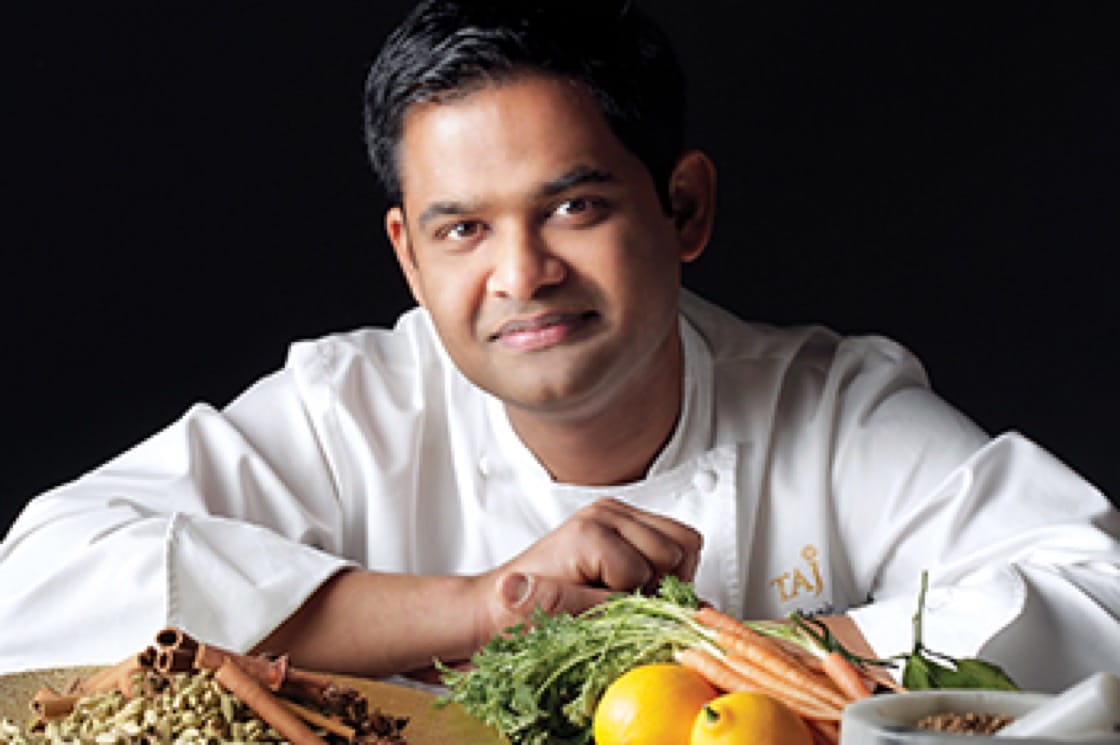If you find yourself peckish in India, get some chaat, a finger-licking—literally, the word is derived from the word meaning “lick”—street food enjoyed as both an appetizer or late-night snack, and made from anything from potatoes to chickpeas to plantains and ranging from sweet to sour to spicy, plus crunch. Served roadside, one popular chaat is dahi puri, where crisp semolina shells (puri) are filled with potatoes or chickpeas, sweet tamarind sauce and spicy green chutney before being topped with yogurt (dahi). Pop the puri in your mouth, crunch down and savor the tastes and textures: messy and delicious, with no utensils required.
Which makes for an interesting challenge when a chef like Srijith Gopinathan of Campton Place in San Francisco—with alums including Eleven Madison Park’s Daniel Humm—wants to add this tasty chaos to his refined Michelin-starred menu, an idea prompted by a visit to his homeland. “I came back from India and wanted to get this dish on the menu somehow,” he says. “But it would be hard to present it like you get it on the street.” There was also the additional challenge of developing a version of the dish that encapsulated the distinct flavors of where he was raised, through the vibrant food lens of the City by the Bay he now calls his home.

Born in Kerala, South India, a state nicknamed “God’s Own Country” for its natural bounty including tea, coffee, cardamom, black pepper and turmeric, the expansive possibilities of ingredients always influenced Gopinathan’s life. (You may be familiar with Kerala’s famous Tellicherry, a designer black pepper used by chefs like Thomas Keller.)
Growing up, spices populated Gopinathan’s backyard and were utilized in his grandmother’s cooking. He remembers being sent out to procure them. “It’s funny because it’s not like somebody taught us these things. It was second nature to run in the backyard and pick up some black pepper.” Turmeric and ginger were plucked straight out of the ground. “I never used spice powders. We didn’t know anything about spice powders. We used to pound the whole roots in a mortar and pestle or we used to grind them in a stone grinder.”
The first meal Gopinathan remembers helping his grandmother make was at the age of six and was a simple dish of lentils dressed up with mustard, chile pepper and grated coconut served alongside rice to the couple dozen or so farmers cultivating his family’s rice paddies. But the first thing he made on his own as a teenager blended cultures, a sign of what was to come in his professional career. “There were a lot of Anglo-Indians left over from the British rule [in India], and their culture always surrounded us,” says Gopinathan. “I got ideas from them of what was fancy in those days. I wanted to make this damn thing called caramel custard.” He figured that he had the basic ingredients: eggs, milk and sugar. His pantry was missing something crucial, but it wasn’t a problem. “We didn’t have vanilla, but we had cardamom. So I just mixed and matched.”
After that Indian-inflected custard he never looked back. He went on to attend the Culinary Institute of America in Hyde Park and then landed a job perfecting his European techniques with the two-starred Belmond Le Manoir aux Quat’ Saisons in England upon graduating. Eventually, he moved to the Taj Hotels, first in the Maldives and now San Francisco. Campton Place is currently in its eighth year decorated with Michelin stars.

Which brings us back to the challenge of the chaat, the dish kicking off his restaurant’s renowned Spice Route tasting menu. The solution came to him on a spring run in Golden Gate Park, when the ground was gorgeous with colorful blossoms. “Immediately I thought of doing a chaat preparation served alongside crudite with all the vegetables. And I thought that wouldn’t make sense because crudite is not something which we have back home at all. And that’s when I came up with the idea to maybe present the vegetables on the top of the chaat, so people can have the vegetables like a salad, then dig into the spices.”

He quickly nixed the idea of serving it in a regular bowl, which seemed too ordinary. This dish required something more earthy and playful. “I went to a garden shop and bought a lot of pots, and of course you’re not supposed to be serving food in them. I just wanted to see the visual.” He was pleased with the result and obtained some food-friendly pots for the restaurant, in which he served his Cali interpretation of the dahi puri. The yogurt is replaced with yogurt foam, mint chutney with mint ice and tamarind with tamarind gel. The crunchy puri is replaced by a combination of grains and dehydrated olives are used for extra texture and flavoring. Vividly-colored vegetables sit on top. The saucer below the pot is filled with pebbles and moss and San Francisco terroir, plus little bits of dry ice—the secret to the stunning San Francisco fog wafting up from below. (When hot water touches the ice, it fumes.)
It would seem that this part would be the most difficult, but not for chef Sri, or, it seems, anyone with a kid. “The idea of fog wasn’t very hard for me,” he says. “I knew how to create it because I do Halloween things for my son.” It was difficult for one poor runner though, who forgot the jug of hot water when he presented the dish. “He went to the guest and explained the whole dish, with the fog, and when he went to pour, there was no water,” says Gopinathan, giggling. But the server was quick on his feet, and didn’t skip a beat.
“And so my server said, ‘I’m sorry, it’s a hot summer day. There is no fog.’”
Photos courtesy of Campton Place.


















